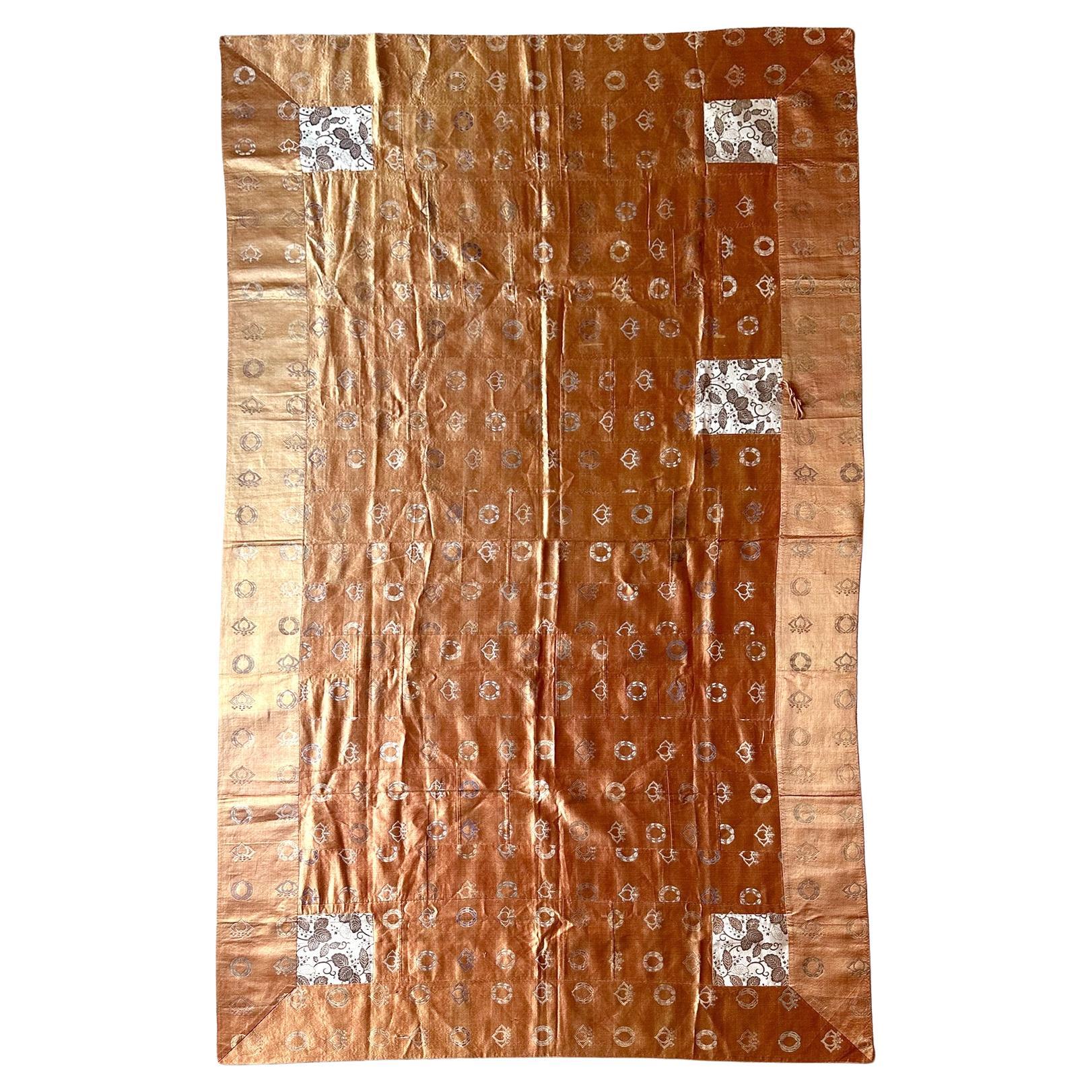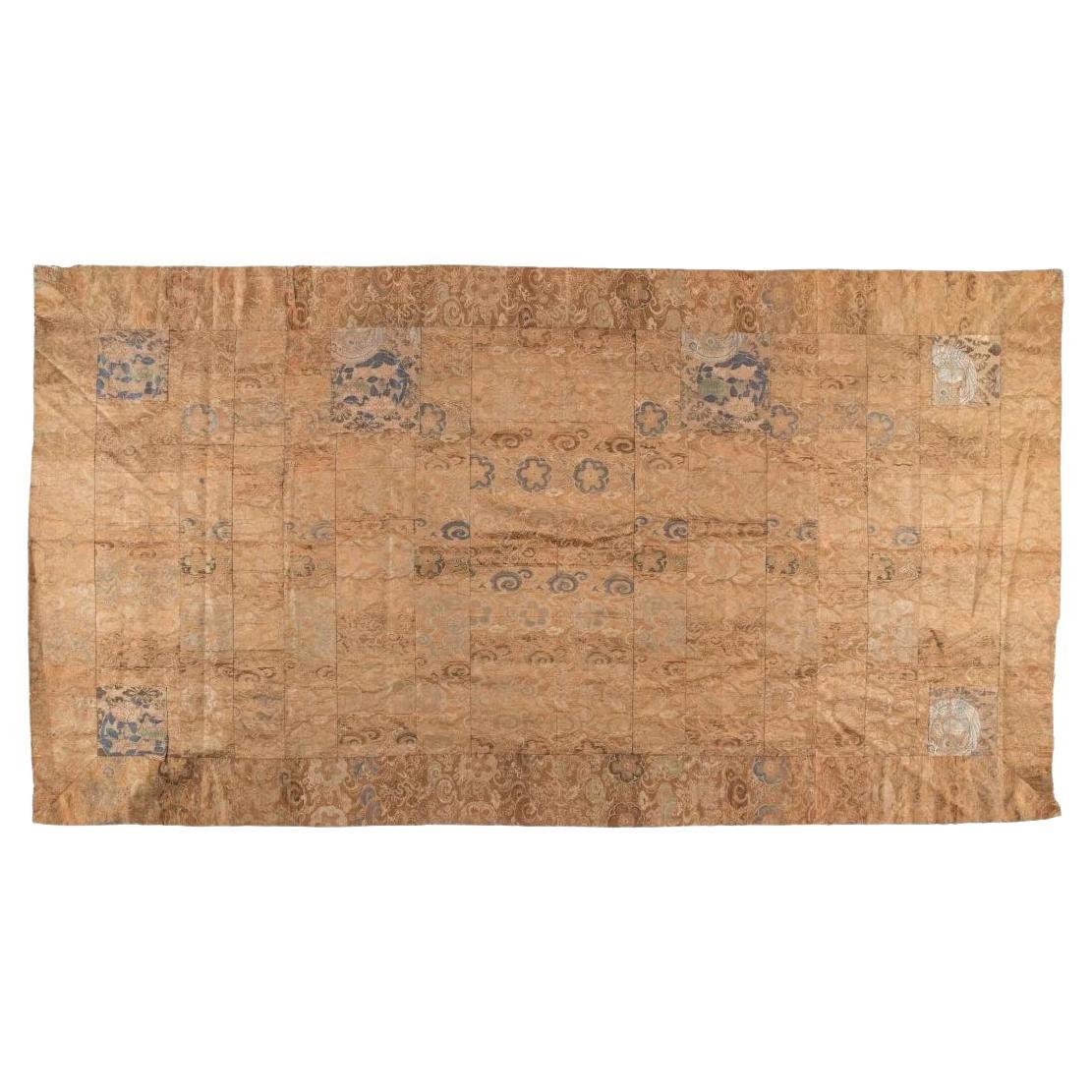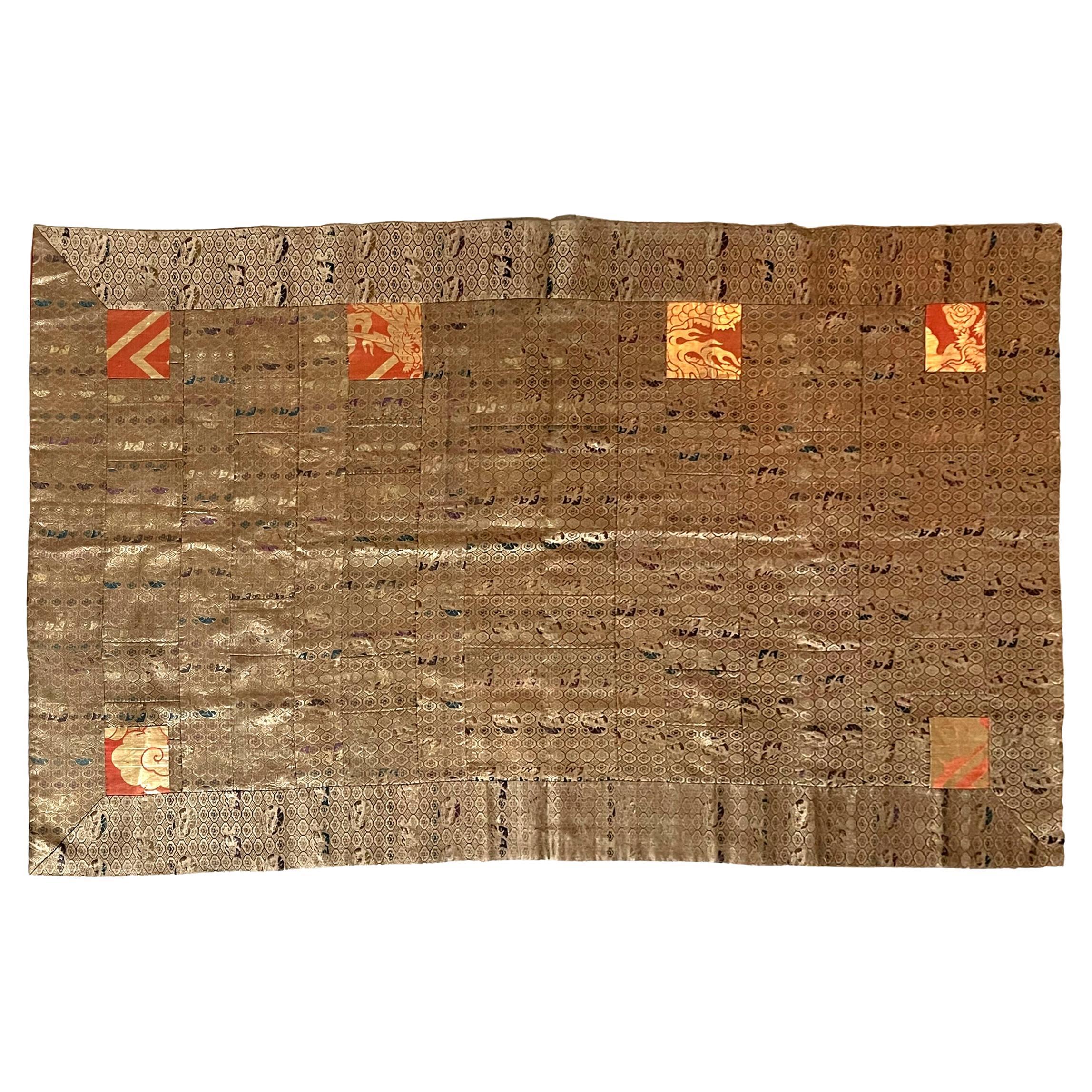Items Similar to Japanese Buddhist Priest’s Silk Mantle (kesa) with Guardian King Appliqués
Want more images or videos?
Request additional images or videos from the seller
1 of 15
Japanese Buddhist Priest’s Silk Mantle (kesa) with Guardian King Appliqués
About the Item
Japanese Buddhist Priest’s Silk Mantle (kesa) with Guardian King Appliqués, dai-e format composed of 13 vertical panels of varying widths and patches surrounded by a broad border, all of the same sumptuous silk brocade fabric. The golden silk ground has a continuous supplementary weft of multi-coloured flowering plants some with kinran. There are six different orange silk “patches” each with an image of a guardian king executed in copper-gold lamellae kinran technique. The original purple silk lining remains with two points of strap attachments.
Condition: The overall condition suitable for mounting.Some breaks and splits to the silk mostly in the top border, some minor stains otherwise good condition.
Measuring: 46 in. high x 83 in. wide ( 117 x 211 cm)
Edo period, circa 1840.
Provenance:
The private collection of Ed Hardy, San Francisco.
Abell Auction Los Angeles, 3/5/23, lot #580.
For similar examples see:
Joe Earle, Japanese Art and Design, The Toshiba Gallery, Victoria and Albert Museum, pp. 92-95, #58.
Minneapolis Museum of Art, accession #: 2011.85
The Metropolitan Museum of Art, accession #:19.93.112 with the following catalog note: “During the making of a kesa, the central column, often larger than the others, is formed first, and the other columns ripple out from the center. This primacy suggests the column's role as the buddha of the mandala, which is often underscored by the presence of the "attendant" squares (niten) that flank the central column. These squares are sometimes said to stand for the bodhisattvas Monju (Sanskrit: Manjushri) and Fugen (Sanskrit: Samantabhadra) or for the two Benevolent Kings (Ni-ō), fierce guardian figures who protect the Buddhist Law. Although it happens only rarely, sometimes the six patches contain woven Sanskrit seed syllables that allow for the identification of the deities. The squares may also feature figural representations of the attendant bodhisattvas and the Guardians of the Four Directions. This kesa contains figural representations of both the Guardians of the Four Directions and the two Benevolent Kings.”
- Dimensions:Height: 46 in (116.84 cm)Width: 83 in (210.82 cm)Depth: 0.25 in (6.35 mm)
- Style:Edo (Of the Period)
- Materials and Techniques:Silk,Appliqué
- Place of Origin:
- Period:
- Date of Manufacture:Circa 1840
- Condition:Wear consistent with age and use. Minor fading. The overall condition suitable for mounting.Some breaks and splits to the silk mostly in the top border, some minor stains otherwise good condition.950.
- Seller Location:Point Richmond, CA
- Reference Number:
About the Seller
4.9
Platinum Seller
These expertly vetted sellers are 1stDibs' most experienced sellers and are rated highest by our customers.
Established in 1999
1stDibs seller since 2015
604 sales on 1stDibs
Typical response time: 2 hours
- ShippingRetrieving quote...Ships From: Palm Springs, CA
- Return PolicyA return for this item may be initiated within 7 days of delivery.
More From This SellerView All
- Japanese Silk Thread Wood Winder Complete with Spool and Functioning GearsLocated in Point Richmond, CAJapanese silk thread wood winder complete with spool and functioning gears. The spool still has the silk thread and an extra spool with different color thread comes with it. The thre...Category
Antique Late 19th Century Japanese Edo Textiles
MaterialsWood, Hardwood
- Edo Period Chain Mail Armor Jacket, Kusari or Karuta, JapanLocated in Point Richmond, CAEdo period Chain Mail Armor Jacket, Kusari or sometimes known as Karuta, Japan Japanese chain mail armor jacket is composed of brass metal plates linked together with metal wires an...Category
Antique Late 18th Century Japanese Edo Textiles
MaterialsBrass
- Taisho-Early Showa Period Japanese Stencil-Dyed Summer Kimono with Bamboo MotifLocated in Point Richmond, CATaisho-Early Showa period Japanese Stencil-Dyed Summer Kimono with bamboo Motif A light-weight summer kimono woven of both cotton and silk, and patter...Category
Mid-20th Century Japanese Taisho Textiles
MaterialsSilk, Cotton
- Late Meiji Period Sleeping Kimono / Yogi, JapanLocated in Point Richmond, CALate Meiji Period sleeping Kimono / Yogi, Japan Yogi are a type of oversized sleeping kimono traditionally used in Japan. This kimono would have b...Category
Early 20th Century Japanese Tribal Textiles
MaterialsCotton
- 9th Century Silver Processional Priest's Hats, Chimu Culture, PeruLocated in Point Richmond, CA9th century silver processional priest's hats, Chimu culture, Peru. These silver hats were originally covered with fabric, as can be seen in the remaining surface pattern. The hol...Category
Antique 15th Century and Earlier Peruvian Tribal Abstract Sculptures
MaterialsSilver
- Meiji Period Japanese Indigo Double Ikat Futon CoverLocated in Point Richmond, CAMeiji period Japanese Indigo double ikat futon cover Japanese futon cover, a double ikat pattern in four panels depicting Kumamoto Castle with im...Category
Antique 1890s Japanese Meiji Textiles
MaterialsCotton
You May Also Like
- Japanese Edo Buddhist Monk Priest 7 Column Silk Brocade Kesa Ceremonial RobeLocated in Studio City, CAA wonderful, brightly coloured and somewhat rare fully intact Japanese Buddhist monk/ priest's Kesa ceremonial silk robe. Kesa (which came from the Chinese word "kasaya") robes have been handmade/handstitched by monks/priests as an act of devotion as ceremonial robes for centuries in various Asian cultures (Japanese, Chinese, Korean, Vietnamese, Indian, etc). The kesa is a rectangular garment designed to be worn over the left shoulder (see example image). The robes are made (often in a patchwork column pattern ranging from five, seven, nine or more pannels) specifically for fully ordained Buddhist monks, priests and nuns and are made from donations of exquisite textiles from wealthy patrons of Japanese Buddhist temples. The robes were used in daily ceremonies, temple gatherings, and private meditation. Antique Kesa robes...Category
Antique 19th Century Japanese Edo Textiles
MaterialsTextile, Brocade, Silk
- Japanese Buddhist Monk Priest 7 Column Silk Brocade Kesa Ceremonial Temple RobeLocated in Studio City, CAA wonderful, beautifully ornamented and somewhat rare fully intact Japanese Buddhist monk/ priest's Kesa ceremonial silk robe featuring various colorful birds in flight. Kesa (which came from the Chinese word "kasaya") robes have been handmade/handstitched by monks/priests as an act of devotion as ceremonial robes for centuries in various Asian cultures (Japanese, Chinese, Korean, Vietnamese, Indian, etc.). The kesa is a rectangular garment designed to be worn over the left shoulder (see example image). The robes are made (often in a patchwork column pattern ranging from five, seven, nine or more pannels) specifically for fully ordained Buddhist monks, priests and nuns and are made from donations of exquisite textiles from wealthy patrons of Japanese Buddhist temples. The robes were used in daily ceremonies, temple gatherings, and private meditation. Antique Kesa robes...Category
Mid-20th Century Japanese Showa Textiles
MaterialsTextile, Brocade, Silk
- Antique Japanese Embroidered Silk Kesa Monk's Robe Edo PeriodLocated in Atlanta, GAA Japanese Kesa (Monk's Vestment) made from thirteen columns of patchworks of fine shimmering silk fabric of a salmon orange color, the shade of which changed subtly from different a...Category
Antique 19th Century Japanese Edo Textiles
MaterialsBrocade, Silk
- Antique Japanese Brocade Kesa Monk's Robe Edo PeriodLocated in Atlanta, GAA Japanese Kesa (Monk's Vestment) made from thirteen columns of patchworks of shimmering woven brocades. The elaborate motifs feature repetitive hibiscus flowers within framework of ...Category
Antique 19th Century Japanese Edo Textiles
MaterialsBrocade, Silk
- Japanese Monastery Robe Patchwork Kesa with inscription Edo PeriodLocated in Atlanta, GAA Japanese Kesa (Monk's Vestment) made from fourteen columns of patchworks of blue brocades with sumptuous woven pattern. The elaborate motifs feature re...Category
Antique Early 19th Century Japanese Japonisme Textiles
MaterialsBrocade, Silk
- Antique Japanese Brocade Kesa Monk's Robe Meiji PeriodLocated in Atlanta, GAA stunning Japanese Kesa (Monk's Vestment) made from thirteen columns of patchworks of shimmering woven brocades. The elaborate motifs feature repetitive...Category
Antique Late 19th Century Japanese Meiji Textiles
MaterialsBrocade, Silk
Recently Viewed
View AllMore Ways To Browse
Art With Gold Thread
Goat Hair Slipper
Moroccan Caftan White Ivory And Gold Brocade Kaftan
Antique Ikat Robe
French Louis Xv Night Stand
Vintage Chair Pair 1930
Bird And Butterfly Porcelain
Ritts Bamboo Side Chair
Coastal Dining Room Set
Metal Coffee Tree Table
Pair Fireside
Art Deco Coffee Table Stone
Black Brass Wall Sconces 24 H
Italian Mahogany Round Table
Japanese Blue And White Painted Plates
20in Writing Desk
Antique Silk Handwoven Rugs
Heavy Wine Glasses





